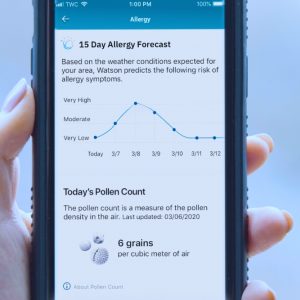AI
How AI and Weather Data Can Help You Plan for Allergy Season
April 23, 2020 | Written by: Rachel Chukura and Misha Sulpovar
Categorized: AI | The Weather Company
Share this post:
 Seasonal allergy sufferers care a lot about what goes on outside with allergens, pollen, air quality, and more. In fact, 68% of allergy sufferers surveyed use weather forecasts and information to help manage their seasonal allergies (Source: AdSales AI Health & Weather Impact Study, Sept 2019).
Seasonal allergy sufferers care a lot about what goes on outside with allergens, pollen, air quality, and more. In fact, 68% of allergy sufferers surveyed use weather forecasts and information to help manage their seasonal allergies (Source: AdSales AI Health & Weather Impact Study, Sept 2019).
As spring continues and summer nears, The Weather Channel data science team has been working to create a resource to help seasonal allergy sufferers. Now available for no charge on The Weather Channel app and weather.com, Allergy Insights with Watson is a new feature that uses AI to help predict the seasonal allergy risk in your area of the United States. With IBM Watson, The Weather Channel offers actionable insights and alerts with a 15-day forecast to help people make more informed decisions and prepare during allergy season.
In researching the issue, the team found that about half (47%) of the people surveyed are self-diagnosing allergies based on symptoms, but 50% are unsure of what they’re allergic to.* Most trackers (including the previous one by The Weather Channel) use three main allergens – tree, grass and ragweed levels – to assess allergy risk. Our scientists actually found that pollen sources are unreliable, spotty and only cover a small subset of species, but also that pollen is not a good predictor of seasonal allergy risk or of how you’ll truly feel.
To repeat: Pollen alone is not a good predictor of allergy symptom risk.
In fact, the team found that using AI and weather data instead of just pollen data resulted in a more accurate picture of allergy risk. Pollen levels are still shown for those who know which allergens affect them, but this is one of the first – if not the first – allergy prediction models that does not focus largely on pollen.
The team used IBM Watson machine learning for local model training of the data in order to help deliver a forecast that’s able to assess the underlying conditions that cause allergens or symptoms and predict your seasonal allergy symptom risk in a given U.S. location. It combines the world’s most accurate weather data ** from The Weather Company – conditions that affect allergy triggers such as temperature, humidity, precipitation, wind and dew point – with anonymized health data and location data (used to understand the environment and local flora).
These data inputs combine with AI technology to meet the scale of The Weather Channel digital properties, which see more than 300 million users monthly and live on the IBM Cloud. Pollen data and air quality data were excluded from the predictive model, since they proved unreliable indicators of seasonal allergy risk, but will continue to be reviewed. References to time of year were also removed, since the start of allergy season has changed over time due to climate change.
Allergy Insights with Watson offers:
- A 15-day forecast to predict seasonal allergy risk level (high, moderate, low), as well as a 3-day forecast for specific seasonal allergens.
- Notifications when seasonal allergy risk is changing to high or dropping to low in the next three days, as well as when you’ll see an elevated level over the next three days.
- Explanations of the correlation with weather and how different weather conditions can potentially affect seasonal allergy risk.
- Pollen levels by allergen (tree, grass and ragweed), as well as push alerts when the level is high, for those seasonal allergy sufferers who know which affect them most.
- Tips to help you reduce seasonal allergen exposure, as well as news articles and editorial content related to allergies
While no two allergy sufferers are the same, knowing in advance when symptom risk might worsen, improve or remain the same can help anyone plan ahead and take action before symptoms may flare up.
Now available for no charge on weather.com and The Weather Channel app for iOS and Android, check your local allergy risk using Allergy Insights with Watson to stay informed this season.
* Based on UserZoom surveys of 450 people by The Weather Company team in October 2019
** ForecastWatch – Three Region Accuracy Overview 2010 through 2017, which is the most recent, most comprehensive study available: https://www.forecastwatch.com/static/Three_Region_Accuracy_Overview_2010-2017.pdf

Offering Manager, The Weather Channel, an IBM Business

Product Lead, Machine Learning and AI, The Weather Channel, an IBM Business
Using Tech for Good Where it Matters Most in Fast Company’s World Changing Ideas
Making the world a better place is a guiding principle embedded in IBM’s core values. As COVID-19 continues to present unprecedented, global challenges for individuals, communities and organizations across the globe, we continue to take a stand and do what’s right to reestablish health and safety across the globe. I’m constantly in awe with the […]
Streaming the South American Solar Eclipse with the Help of the Cloud
Just before sunset on July 2 the moon over South America will pass in front of the sun and shift its umbral shadow from the Pacific Ocean, over La Serena, Chile, across the continent to Buenos Aires, and into the Atlantic. Although locations in neighboring Peru, Ecuador, Brazil, Uruguay and Paraguay will be able to […]
Bringing Precision Weather Forecasting to Motorsports with Aston Martin Red Bull Racing
From precision manufacturing and aerodynamic calibration, to tire selection and race-day strategy, Formula One racing is a data-driven sport. To win, racing teams must excel on the razor’s edge, balancing control and strategy with technology and the ability to make critical, real-time decisions in a high-stakes, high-speed environment. Cars can accelerate to 100mph in less […]


